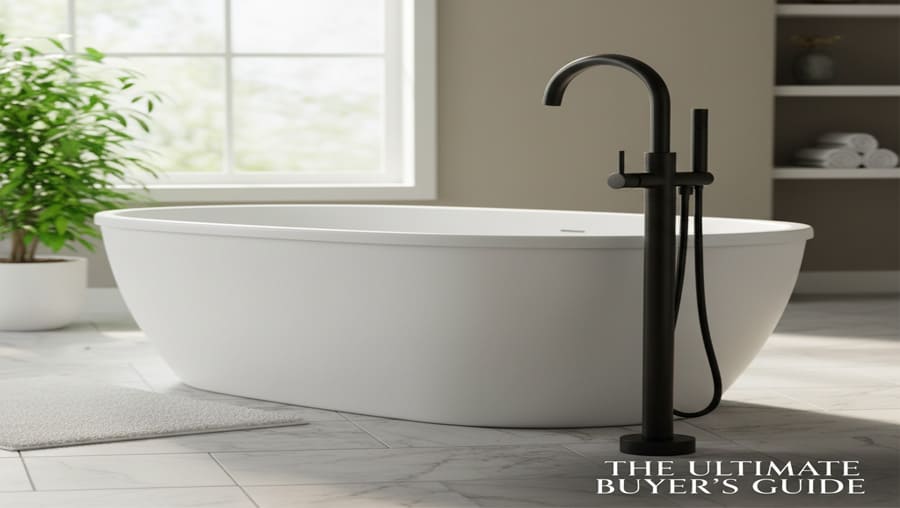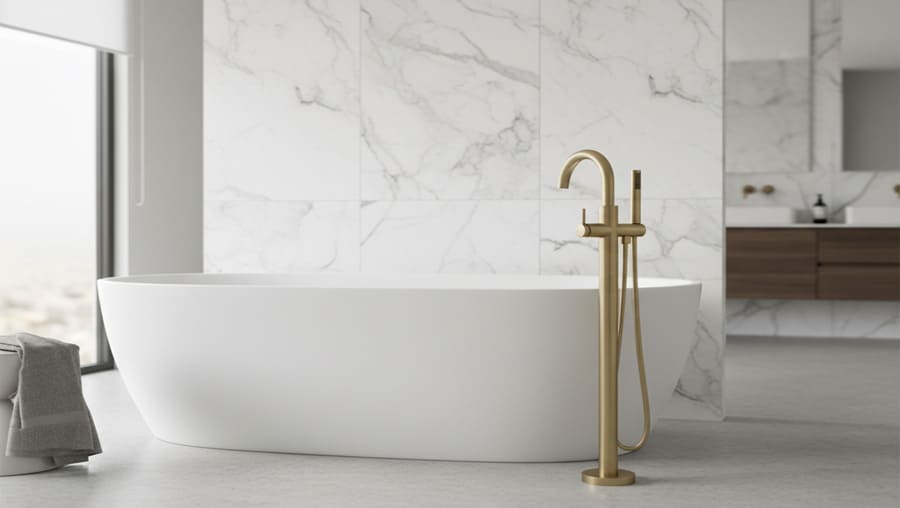You’ve invested in a beautiful freestanding bathtub, the stunning centerpiece of your dream bathroom. But now you’re faced with a critical question: how do you get water into it? The answer is a fixture as elegant and commanding as the tub itself: a freestanding tub faucet.
Unlike a standard faucet that mounts to a wall or a tub deck, a freestanding tub faucet (also known as a floor-mount tub filler) is a tall, self-supporting fixture that rises directly from the floor. Choosing the right one is essential for your bathroom’s functionality and aesthetic. This guide is your complete roadmap, designed to walk you through every technical detail and style choice, ensuring you select a faucet that is not just beautiful, but perfect for your space.
Last Updated: Nov 2025 | Estimated Reading Time: 20 minutes

What Exactly is a Freestanding Tub Faucet?
At its core, a freestanding tub faucet is a specialized plumbing fixture designed exclusively for standalone bathtubs that have no deck or adjacent wall for mounting a traditional faucet. It is a complete, all-in-one unit that brings hot and cold water up from beneath the floor.
Every freestanding tub faucet consists of three main components working in harmony:
- The Spout: The primary, often gracefully curved, pipe that delivers the main flow of water to fill the tub.
- The Hand Shower: A versatile, detachable hand-held sprayer that is perfect for rinsing your hair, cleaning the tub, or bathing children and pets.
- The Diverter: A knob or lever that allows you to switch the water flow between the main spout and the hand shower.
| Component | Primary Function | Why It’s Important For You |
|---|---|---|
| Main Spout | Fills the bathtub quickly and efficiently. | The spout’s height and reach must be correct to clear the rim of your tub without splashing. |
| Hand Shower | Provides a targeted, flexible stream of water. | Adds immense practicality and a spa-like feel to your bathing experience. |
| Diverter Valve | Switches water flow between spout and hand shower. | A high-quality diverter ensures a crisp, leak-free switch between functions. |
The Crucial First Step: Understanding Installation & Plumbing
This is the most important section of this guide. Unlike other faucets, a freestanding tub filler requires significant planning before your floors are finished. Getting this wrong can lead to costly renovations.

The Hidden Hero: The Rough-In Valve
The faucet you see is only half the story. The other half is the rough-in valve, a brass assembly that is installed beneath your finished floor. This valve connects to your home’s hot and cold water supply lines and serves as the secure, stable base onto which the visible faucet is mounted.
- For New Construction: Your plumber must know the exact location of your tub and faucet before pouring the concrete slab or installing the subfloor. The supply lines and rough-in valve must be installed at this stage.
- For Renovations: This is more complex. Your contractor will need to open the floor to access the joists, run new supply lines, and securely mount the rough-in valve to the floor structure. You absolutely must plan for this extra work.
Expert Tip: Always ensure the rough-in valve is included with your faucet purchase. Some brands sell them separately, leading to compatibility issues. A complete kit from a reputable source ensures a perfect fit.
Floor Stability is Non-Negotiable
A freestanding faucet can be over 40 inches tall. When you pull on the hand shower or turn the handle, it exerts leverage on its base. The floor structure (subfloor and joists) must be solid and properly reinforced to prevent any wobbling or flexing, which could lead to leaks over time.
How to Choose Your Perfect Freestanding Tub Faucet: 5 Key Factors
Now that you understand the technical groundwork, you can focus on choosing the faucet itself. These five factors will determine its quality, longevity, and style.
1. Material & Construction: The Core of Quality
The material your faucet is made from is the number one indicator of its long-term durability. The two best choices are Solid Brass and Stainless Steel.
- Solid Brass: The long-standing industry standard for premium faucets. It is exceptionally durable, resistant to corrosion, and feels heavy and substantial. It is the perfect base material for a wide variety of finishes like chrome or matte black.
- Stainless Steel (SUS304): A fantastic modern alternative. It is inherently lead-free and will not corrode or tarnish, even in its raw, brushed state. It offers a sleek, professional look and is extremely hygienic.
| Material | Key Advantages | Best For You If… |
|---|---|---|
| Solid Brass | Heavy, durable, industry-proven, excellent for plating finishes. | You want the widest possible range of color finishes and a traditional, substantial feel. |
| Stainless Steel | Naturally lead-free, will never rust, modern aesthetic, highly hygienic. | You desire a modern, minimalist look and prioritize health and sustainability. |
For those seeking the ultimate in modern design and durability, a manufacturer specializing in stainless steel is an excellent choice. For example, the SpringFaucet collection of freestanding tub faucets is crafted from high-grade SUS304 stainless steel, offering a lead-free, corrosion-proof solution perfect for contemporary bathrooms.
2. The Heart of the Faucet: The Valve Cartridge
Inside the handle is the valve cartridge—the part that actually controls the water flow and temperature. This is where quality matters most.
Look for one thing: a Ceramic Disc Cartridge.
This type of cartridge uses two ultra-hard, perfectly flat ceramic discs that shear against each other. When aligned, water flows; when separated, they create a watertight seal.
- Benefit 1: Drip-Free Performance: They are incredibly durable and not prone to the rubber washer decay that causes traditional faucets to drip.
- Benefit 2: Smooth Operation: They provide a smooth, effortless handle motion for precise temperature and volume control.
Pro Tip: Ask your supplier or check the product specifications for “ceramic disc cartridge.” A quality manufacturer will always highlight this feature. It’s a non-negotiable for a long-lasting faucet.
3. Style & Design: Matching Your Bathroom’s Soul
Freestanding tub faucets come in three primary design families. Your choice should complement your bathtub and the overall aesthetic of your bathroom.
| Style | Key Features | Pairs Best With… |
|---|---|---|
| Modern / Contemporary | Clean lines, geometric shapes (square or cylindrical), minimalist details. | Sleek, simple soaking tubs with thin rims and minimalist design. |
| Traditional / Classic | Ornate details, curved spouts, decorative levers or cross handles. | Classic clawfoot tubs or pedestal tubs with vintage-inspired details. |
| Transitional | A blend of modern and traditional. Clean lines with soft curves, simple but elegant. | Versatile tubs, such as a modern skirted tub or a simplified pedestal tub. |
4. Finish: The Final Touch of Elegance
The finish is the protective and decorative coating on your faucet. Your choice dramatically impacts the final look.
- Polished Chrome: The timeless classic. Durable, easy to clean, and matches virtually any decor.
- Brushed Nickel / Stainless Steel: A softer, warmer metallic look that resists fingerprints and water spots well.
- Matte Black: A bold, modern choice that creates a dramatic statement. It’s a key feature in industrial and minimalist designs.
- Brushed Gold / Champagne Bronze: A luxurious, warm finish that adds a touch of glamour and sophistication.
For the best durability, look for finishes applied with PVD (Physical Vapor Deposition). This advanced process bonds the finish to the metal at a molecular level, making it far more resistant to scratching and tarnishing than standard electroplating.
5. Functionality & Flow Rate (GPM)
The flow rate, measured in GPM (Gallons Per Minute), tells you how quickly the faucet can fill your tub. A standard freestanding tub holds 50-70 gallons.
- Low GPM (2.0 – 4.0): Will result in a slow fill time. Your water may get cool before the tub is full.
- High GPM (6.0 – 10.0+): Fills the tub quickly, ensuring a hot bath. This is highly desirable for large soaking tubs.
Check the product specifications for the GPM. A higher GPM requires your home’s plumbing to have adequate water pressure and supply line diameter (typically 3/4 inch) to support it.
Sourcing Your Faucet: OEM/ODM Partners vs. Retail Brands

When you start shopping, you’ll encounter two main channels:
- Retail Brands: Well-known brands you find in showrooms or big-box stores. You are buying an off-the-shelf product with the brand’s reputation and warranty.
- OEM/ODM Manufacturers: These are the factories that often produce faucets for the big retail brands. Sourcing directly from a specialist manufacturer like SpringFaucet can offer significant advantages, especially for trade professionals.
The Advantage of a Specialist Manufacturer
For designers, contractors, or businesses developing their own product line, partnering with a manufacturer offers:
- Cost-Effectiveness: By going directly to the source, you can achieve better pricing.
- Customization (ODM): You can work with the manufacturer to create a unique design or modify an existing one with specific finishes or features.
- Quality Control: Direct communication with an ISO9001 certified factory like SpringFaucet ensures you have oversight of the production process and material quality.
- Flexibility: Specialist manufacturers often provide flexible MOQs (Minimum Order Quantities), making it accessible for smaller projects or new brands.
Exploring the freestanding tub faucets on SpringFaucet’s website is a great way to see the range of modern, high-quality options available directly from a manufacturing expert.
Frequently Asked Questions (FAQ)
Q1: Can I install a freestanding tub faucet on a heated floor? Yes, but it requires careful planning. The plumber and the flooring installer must coordinate to ensure the rough-in valve and water lines do not interfere with the heating elements. A buffer zone around the faucet base is essential.
Q2: My freestanding faucet wobbles. How can I fix it? A wobbly faucet is almost always due to improper installation. The cause is either a poorly secured rough-in valve under the floor, or the visible faucet not being tightened correctly to its base plate. This needs to be addressed immediately by a plumber to prevent leaks.
Q3: How far should the faucet be from the bathtub? The spout should extend several inches over the rim of the tub to prevent water from splashing onto the floor, but not so far that it becomes an obstacle. The ideal placement is centered on the tub’s long side, in a position that is comfortable to reach from both inside and outside the tub.
Conclusion: Investing in the Perfect Centerpiece
Choosing a freestanding tub faucet is a significant decision that blends bold design with critical engineering. It is more than just a tap; it is a sculptural element that completes the vision of your luxury bathroom.
By prioritizing a solid installation plan, selecting high-quality materials like solid brass or stainless steel, insisting on a ceramic disc cartridge, and matching the style and finish to your decor, you are making a wise investment. Whether you choose a well-known retail brand or partner with a specialist manufacturer like SpringFaucet for greater flexibility and value, you now have the expert knowledge to select a freestanding tub faucet that will perform flawlessly and look stunning for years to come.
Recommended Links
Internal Links:
External Links (Authoritative Sources):
- Plumbing & Drainage Institute (PDI) – An authoritative body on plumbing standards and practices.
- Wikipedia: Faucet Valve Types – For a technical understanding of why ceramic disc valves are superior.
- National Kitchen & Bath Association (NKBA) – A leading source for professional bathroom design trends and guidelines.
